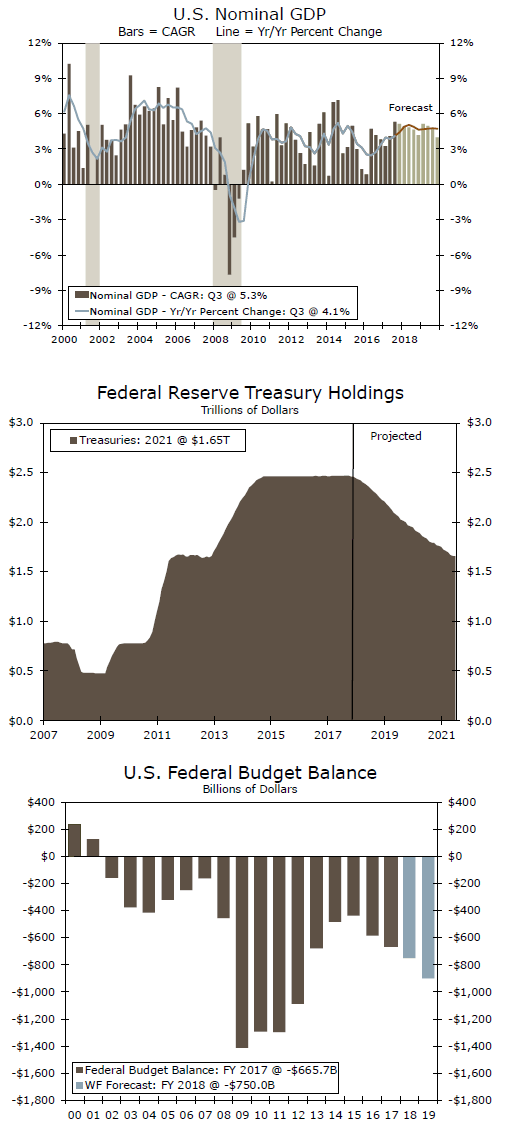Day-to-day, countless factors drive gyrations in the Treasury market. The key fundamentals, however, drive the underlying trend, and we believe these factors are poised to drive U.S. Treasury yields higher in 2018.
Fundamental #1: Economic Growth and Inflation
The case for higher U.S. Treasury yields in the United States in 2018 starts with the most basic of fundamentals: economic growth and inflation. When the 10-year U.S. Treasury yield reached a cycle low of 1.36 percent in the summer of 2016, it occurred at a time of global tumult related to the Brexit vote, but the underlying fundamentals of both U.S. economic growth and inflation were also very soft (top chart). Real GDP growth was a paltry 1.5 percent in 2016, and the PCE deflator rose just 1.2 percent over the same period. In 2017, real GDP accelerated to roughly a 2.3 percent pace, while inflation as measured by the PCE deflator strengthened to 1.7 percent.
Faster economic growth/inflation has pushed nominal GDP growth back to a 4 percent year-over-year pace, and we expect the upward trend to continue in 2018. We expect real GDP growth of 2.7 percent this year and for inflation to drift closer to the Fed’s 2 percent target. A continued acceleration in GDP and prices suggests these two key fundamentals will be supportive of higher yields on U.S. Treasuries this year.
Fundamental #2: Monetary Policy
With faster growth/inflation and a falling unemployment rate, the FOMC is positioned to hike the fed funds rates multiple times for the second year in a row. We expect three rates hikes this year, occurring in March, June and September. If realized, this would put the fed funds target range at 2.00-2.25 percent by year end. The FOMC dot plot suggests a neutral rate of 2.50-2.75 percent, signaling that another year of three rate hikes would put the Fed within spitting distance of a "normal" stance of monetary policy, at least in regard to the fed funds rate.
With regards to the Fed’s balance sheet, monetary policy remains more accommodative, but here too the fundamentals suggest upward pressure on Treasury yields. The balance sheet reduction program initiated last October will see the run-off caps rise to $50 billion/month in Q4-2018 for Treasuries and MBS. If the Fed follows its stated plan, approximately $230 billion in Treasury debt would mature and not be reinvested in 2018 (middle chart). Steady increases in the fed funds rate and snowballing balance sheet reductions suggest an upward shift for the yield curve in 2018.
Fundamental #3: Treasury Supply
After steadily failing through FY 2015, the federal budget deficit has begun to rise again (bottom chart). As a result, the supply side of the Treasury market will see a surge of new issuance due to several factors: secular pressures related to the aging Baby Boom generation, additional spending from an expected budget deal and for hurricane/wildfire related emergencies and lower tax collections as a result of the tax overhaul bill passed in December. A jump in net issuance represents an additional catalyst for higher Treasury yields in 2018.

